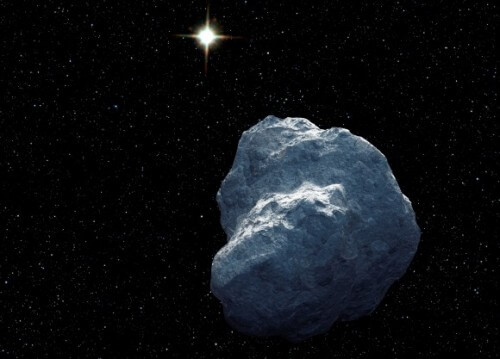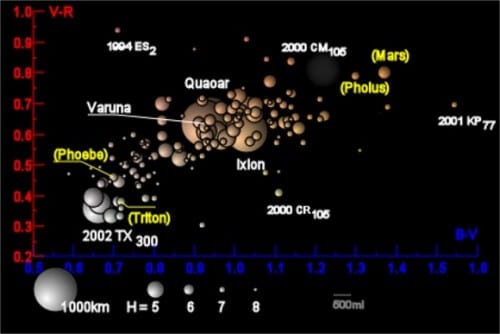Two undergraduate students have found evidence of the possible existence of dwarf planets beyond Neptune in the images of a sky survey searching for dark energy. The two, led by a professor from the University of Michigan, presented their findings at the American Astronomical Union conference

Telescope and computer viewing time is what is needed to stare at the same areas of the sky in a cyclical manner. This method is applied by the Dark Energy Survey (DES), which after scanning less than one percent of the sky it is supposed to scan has yet to find any clues to the nature of dark energy but has managed to discover previously unknown objects in the outer solar system.
The Dark Energy Survey is a five-year partnership that uses ground-based telescopes to observe supernovae to understand the structure of the universe and its expansion. But in the meantime, objects traveling much closer to home pass through the field of view. Trans-Neptunian objects - small ice worlds beyond the orbit of Neptune-Rahab were discovered in this way. A scientific paper published during the American Astronomical Society conference in Seattle revealed the newly discovered objects. The principal investigators are undergraduate students from Carleton College in Northfield, Minnesota, participating in the University of Michigan program.
Two telescopes at the Plumer Observatory, the Sloan digital sky survey and all other sky surveys mapped not only the static night sky - the unchanging, but also temporary events such as transits of asteroids and comets or novae. The Dark Energy Survey watches the night sky and looks for cosmic structures and the characteristics of the expansion of the universe. After part of the five years of the survey, the survey had time to observe ten fields in the sky with an area of 3 square degrees each for type 1 supernovae which it discovered on a weekly basis.
As the survey progressed, its operators achieved more than they expected. The survey reveals the existence of new trans-Neptunian objects. And once again, a survey of deep space reveals the secrets of our local environment - objects in the solar system's book regions.
DES observing the sky in the visible light field in search of supernovae can, weather permitting, measure the expansion of the universe. This judgment depends on the mutual reaction between matter and elusive substances in our universe - dark energy and dark matter. The five years of the survey are required to achieve a good level of detail and a large number of supernova events from which conclusions can be drawn.
In the meantime, the young researchers from Carleton - Ross Jennings and Zhilo Zhang discovered dwarf planets in our solar system. Led by Prof. David Gerdes from the University of Michigan, the two started with a list of 100 observations of transits of temporary objects. Different software and their speed analysis made it possible to differentiate between objects past Neptunes compared to, for example, asteroids in the inner solar system.
While asteroids will pass quickly through a field of view as small as the survey's field of view due to their proximity, trans-Neptunian objects orbiting the Sun will move much more slowly. For example, Pluto, which orbits the Sun at an average distance of 40 astronomical units, as well as the dwarf planet Eris - the two largest trans-Neptunian objects known to us move a distance of 27 seconds of arc per day, although for six months the movement of the Earth around the Sun advances or moves away The observed motion of Pluto. 27 arcseconds is about one-sixtieth of the diameter of the full moon, so from one night to the next the trans-Newtonian objects cross about 100 pixels along the field of view of the DES detector, since the width of each pixel is 0.27 arcseconds.
The DECam scientific sensor array is located at the Inter-American Observatory in the city of Coro Talodo in Chile, and is connected to a 4 meter diameter telescope. The array contains 62 sensors of 2048×4096 pixels and a total of 520 megapixels. The total weight of the camera is 20 tons.

After a little more than two years of observation, the young researchers say, "Our analysis revealed 16 previously unknown objects in the outer solar system, including one Trojan object of Neptune, several objects that are in coordinated motion with Neptune, and one object that orbits the Sun for 1,200 years, one of the orbital periods The lengths of known objects in the solar system.
If these discoveries are confirmed, it means that the outer solar system is full of objects made of rocks and ice. There is another meaning to these discoveries - for example, when they come to look for other bodies that the New Horizons spacecraft will be able to reach after passing by Pluto in the middle of the year. As New Horizons approached Pluto, the crew turned to the Hubble Space Telescope to help search for a trans-Neptunian object that would serve as the next target. However, the demand for Hubble observation time does not allow long-term searches for trans-Neptunian objects. Surveys like DES will be used to uncover thousands more such objects in the outer solar system. As Prof. Michael Brown of Caltech pointed out - there is a reasonable chance that a planet the size of Mars or even the size of the Earth will be found in the Oort cloud beyond Neptune.

6 תגובות
Dan
You are now reading a dark article about dark matter when the title is probably also dark about the subject (when can you observe dark energy with a telescope? Maybe it means observing dark matter).
Can't see anything beyond the message title hides…
If we're already discussing all the small details, then we "gobble up the distance", and don't gobble up the distance".
By the way, the illustration of the "Neptunian past" bodies is one of the most unclear graphs I've ever seen (also on the source site).
In the article it is said: 27 seconds of arc is about one-sixtieth the area of the full moon. End quote. It should of course be "the diameter of the moon". instead of "shitho". Besides, my opinion on the "no mass and dark energies" is known, so he did not add.
Good night
Yehuda
The typos have been corrected.
Don't you have a spell checker? Even if you are in a hurry it takes seconds